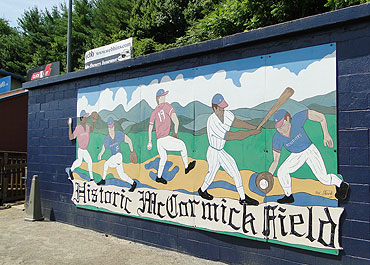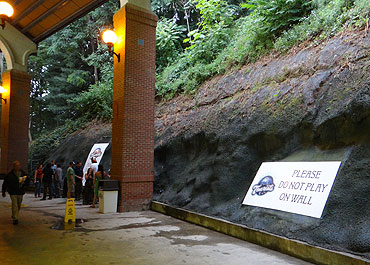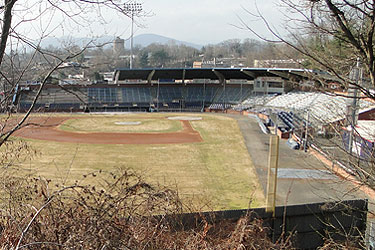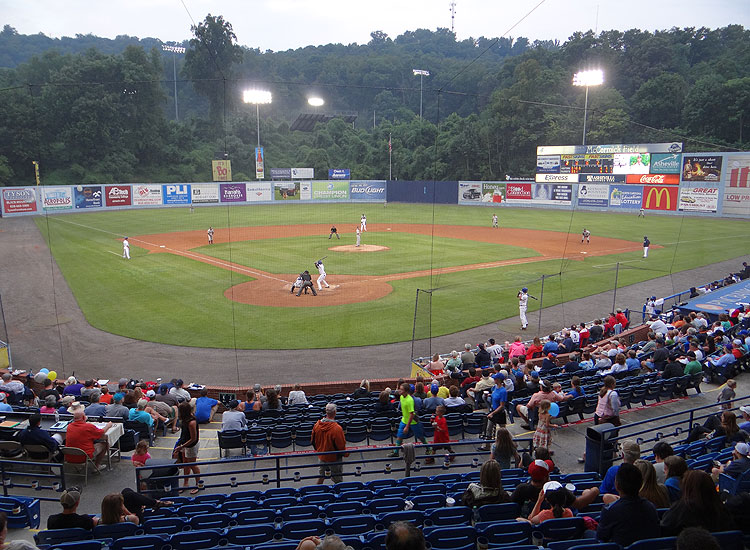Notably, it's a place where its placement has constrained its confines. For example, it's only 297 feet from home plate to the 36-foot tall wall in right field because a tree-covered hill rises there just behind the old school looking fence, which is made of ridged tin. And then there's the third base concourse, which is narrow out of necessity since it abuts a rock-faced hillside. The closeness of the natural topography shadowing what's the visitors' side of the ballpark explains why there's more to the stadium on its first base side than third, where the unsymmetrical grandstand ends not too far past the bag.
Location is a big part of this ballpark's story, but so too are the legends who have played on its field, which debuted in 1924. Babe Ruth, Lou Gehrig and Jackie Robinson are most famous among them, and black and white banners of names you know legends who have played on McCormick's field are wrapped around the numerous doors on the concourse and elsewhere.
While the field is legitimately historic, the stadium that surrounds it is much less so, although its footprint mostly mimics what has been there from the get-go. The grandstand and cantilevered roof that partly covers it date to only 1992, when a rebuild of the previously wooden grandstand was completed. The 4,000-seat concrete structure is strikingly brick-framed and its roof, which spans eight upper (above the cross aisle) level seating sections, is nicely lined with lighting about halfway up its underside.
Despite being skyboxless, you can seemingly watch a game from the sky thanks to bleachers on the hill above center field. The 20-row high set of stands face the hilltop football/soccer field but ascending to their top and looking back provides a scenic view of the ballpark, ballgame and Asheville skyline. It's certainly worth your while to walk up the hill to enjoy an inning (you can pretty much see the whole field) and take some photos of one of the best ballpark views imaginable.
For the first 22 years of its rebirth, more views from within McCormick Field were yielded from bleachers than box seats, and each upper end of the grandstand lacked any seats at all -- you simply sat on concrete. Alas, that aspect of a throwback ballpark is no more, as in 2015 modern seating -- stadium-style chairs with cup holders -- was installed just about everywhere (four rows of bare concrete "seats" remain).
Such an update shed some of its simpleness, but McCormick Field still feels old in a good, nostalgic way and the home of the Asheville Tourists is one that baseball tourists should enjoy as the remarkably located venue and its views are certainly memorable.
There's a limited about of small commercial enterprises near the ballpark, with a gas station directly across the street from it. A whole lot of places to dine, drink and visit are in Asheville's downtown area, which is less than a mile away via Biltmore Avenue, the road to reach the city's center by. You do that by driving uphill and north. Going the other way on the same avenue will take you to Asheville's most famous and visited tourist attraction, the 8,000-acre Biltmore Estate, which is about 2 miles south of where the Tourists play. Completed in 1895 and billed as America's largest home, the 250-room Biltmore House and its sprawling grounds are toured by some one million folks annually.
As for access, two Interstates are near McCormick Field. I-240 is north, east and west of the ballpark while I-40 is south of it. From the closest exit (#5B), I-240 is just one mile away. It's a 2.5 mile drive between the Tourists' ballpark and I-40 (using exit 50).
Group areas are at the far end of each outfield line. In the right field corner, a simple tent is set up so up to 100 people can enjoy a pre-game picnic under cover. The left field pavilion area is much bigger as it also has patio chair drink rail seating alongside the left field line's brick retaining wall. Since the outfield line seating extends all the way to the third base side grandstand it's accessible to everyone when groups are not using them or have abandoned the area later in the game. The right field pavilion is far removed from the grandstand and is thus inaccessible to all but the groups using it.
 |
 |
| A sign of former times at McCormick Field is seen upon the visitors' clubhouse building, where a mural that had graced the facade of the old stadium has found a home inside the 1992-opened version. A large unmovable object -- the solid rock wall at the base of a hill -- provides a naturally unique end to the stadium's third base side confines and concourse. |
Ballpark History
The site for Asheville's first municipally owned athletic park was chosen on May 29, 1923, and thus began the quite colorful history of McCormick Field.
Selected from among five tracts of land by a group of newly elected city commissioners, the approximately 15-acre site known as the Buchanan property was purchased by the City of Asheville from its owners, neither of whom were named Buchanan.
The sellers were Wilbur Devendorf and Frank A. Barber and a prime reason the city chose their property was its proximity to Asheville High School, "for which the athletic field is primarily intended," stated The Asheville Citizen, which reported the Buchanan property’s value "at around $30,000." The set of stands that would be built there cost $18,000.
Even before construction began on the site the athletic field to be built there had its name. Just 18 days after site selection Asheville's Board of City Commissioners approved a proposal made by the city's public works commissioner to honor the memory of prominent bacteriologist Dr. Louis M. McCormick, who earned national acclaim in 1905 while on the city payroll for devising a plan of action to rid Asheville of its flyborne disease problem by urging citizens to "swat that fly" with a recent invention: the fly swatter.
As simple as it sounds, swatting flies combined with often cleaning the city’s filthy livery stables solved the health nuisance an overabundance of the pests can cause. Other cities took note of the success and because of Dr. McCormick’s housefly eradication tips his name would be known well beyond Asheville, where 27 months after the doctor died the ballpark that bears his last name officially opened on April 3, 1924.
The Ty Cobb-led Detroit Tigers were the first houseguests of Asheville’s baseball team, which was known as the Skylanders at the time, when 3,199 paid their way into opening day at McCormick Field for a 3:30 exhibition between the barnstorming major league club and their minor league hosts. The crowd saw a slugfest surprisingly won by the local nine.
Although the Skylanders were 18-14 winners the Tigers hit four of the six home runs on the day, including one by player/manager Cobb. While the longball was still a rarity in 1924 – the Tigers hit just 35 in their ensuing 154-game regular season – it was no surprise that all homers hit in game #1 cleared the boundary fence in right field, as the foul line distance to it from home plate was merely 257 feet. The down the line distance to left field was a perfectly acceptable 320 feet.
Big league teams on tour during spring training brought many big-time names to McCormick Field in its early years. The Yankees of Babe Ruth and Lou Gehrig fame played multiple games in Asheville, although the Babe became so ill prior to what was to be his first game there in 1925 that he had to be hospitalized. Ill-advised news reports then went so far as to say that Ruth had died in Asheville. In reality, Ruth had an intestinal abscess that required surgery and kept him in the hospital for nearly 50 days upon his return to New York. His North Carolina-begun ailment went down in history as "the bellyache heard 'round the world."
A healthier Bambino returned to Asheville in 1926 for two Yankees-Dodgers exhibitions that were never played due to rain. But while surveying the city’s then two-year old field and its surroundings Ruth is said to have said, "My, my, what a beautiful place to play. Delightful. Damned delightful place!"
Finally, in 1931 the Babe got to play in the delightful place, homering in back-to-back days as his Yankees completed a three-game series sweep of the Tourists.
During spring training on the evening of March 28, 1935 most of McCormick Field’s original wooden stands went up in flames, as fire destroyed the 3,500-seat main grandstand and negro bleachers in left field, which had a capacity of 500. Firefighters were able to save about half of the 700-seat white bleachers section along the first base line.
The city carried a $7,500 insurance policy on the stands and work began to replace them the day after the fire, when a 25-man workforce started to clear the charred remains at 12:30. The scene then was certainly far different from the afternoon before, when a practice game was played on the field between teams of St. Louis Cardinals prospects. The Tourists were affiliated with the Cardinals from 1935 through 1942.
While decades of minor league games and occasional exhibitions featuring major league teams are the primary focus of McCormick Field lore, lots of athletic events besides baseball have occurred within its confines.
As intended, Asheville High School used McCormick Field. The school's football team played there from the get-go, and continued to do so through 1948.
From 1956-58, baseball and football were absent all together, as a quarter-mile asphalt track turned the ballpark into McCormick Field Speedway. NASCAR even held one of its top tier races there on July 12, 1958, a 150-lap Grand National race with 15 participants. Jim Paschal led from start to finish and earned $570 for the win.
 The last time the scene from above left field didn't look a lot like this was in 1958, when a racetrack was within McCormick Field.
The last time the scene from above left field didn't look a lot like this was in 1958, when a racetrack was within McCormick Field.
|
After three years of stock car racing baseball returned in 1959 following $30,000 in improvements to make McCormick Field a former speedway. The oval track, of course, was removed, and the grandstand, bleachers, press box and clubhouses were all spruced up.
Minor league baseball has been played on the field continuously ever since, with the team called the Tourists for all but four seasons.
The Asheville Orioles played at McCormick from 1972-75, with Cal Ripken managing the team for the first three of those years. His sons, Billy and Cal Jr., spent those summers serving as batboys for their Dad’s team. Cal Sr. would later manage both his boys in Baltimore and Cal Ripken Jr. advanced from part-time batboy in Asheville to become an all-time great in the major leagues, earning him enshrinement into the Baseball Hall of Fame in 2007.
An equally well-known movie star shot some scenes at McCormick Field, as Kevin Costner, playing the part of Crash Davis, set the career minor league home run record by hitting his fictional 247th in Asheville as a member of the Tourists in the iconic movie "Bull Durham," which was shot on location following the 1987 season (October 5 and 6 were the filming dates).
"Bull Durham" was released on June 15, 1988 and McCormick Field made its cameo near the end of the 108-minute flick. But the ballpark as it appeared during Costner’s character’s arrival and historic at-bat didn’t have much time left, as plans to replace the wooden place, which was necessary for fire liability reasons, began with discussions between team and government officials in September of ’88.
Talks progressed to the point where in September of 1989 a plan was unveiled by HOK and a local firm for "a similar-sized, rebuilt stadium on the same site." HOK was not too well known yet – that would change in 1992 when their creation in Baltimore, Camden Yards, debuted – and the $3.9 million to $4.5 million price tag they assigned to the design was deemed too much money to spend by Buncombe County, which would be paying for the new home of the Tourists in their county seat city of Asheville.
Although owned by the city in the beginning, the county was owner/operator of what was the oldest active ballpark in minor league baseball on August 14, 1990, when the Buncombe County Board of Commissioners approved spending $2.5 million on a scaled-down design produced by another set of architects, Bowers, Ellis & Watson, whose Asheville firm dated only to 1988.
So the fairly new kids on the block earned the task of replacing the oldest ballpark then on any minor league block.
Technically, the job was considered a renovation. "The facility was rebuilt in concrete replacing the largely wood [structure] but keeping a similar layout to the original McCormick Field," is how the designers defined their work a quarter-century after money was made available to make an updated McCormick Field resemble what started to be torn down on September 12, 1991.
Just a couple days prior, "a softer-than-expected earthen bank" found under the old stands forced county commissioners "to scrape together another $500,000," the Asheville Citizen-Times noted.
And thus the price tag for McCormick Field II was $3 million. Taxes were raised slightly in Buncombe County to fund it.
A flock of 4,116 turned out to gather in the new stadium surrounding the same old oriented playing field on April 17, 1992, which was a rainy Friday night, when the Asheville Tourists played the Spartanburg Phillies after an estimated 2,000 people were denied admission into the fully packed new McCormick Field, which was filled with 884 red-colored box seats and enough space on aluminum and concrete bleachers to bring the ballpark’s official seated capacity to 3,500.
With all seats (and presumably nooks and crannies) filled, the visitors from Spartanburg shutout the Tourists of Asheville, 3-0, on opening night, when the game got underway at 7:45.
The Tourists got their first win in their new again home in its second game on April 18, beating the Phillies 2-1 before a Saturday night crowd of 1,526.
Despite its bandbox dimensions, the rebuilt McCormick didn’t have a ball clear its fences until game #3, when a 19-year old in an 0-for-15 slump homered to left field for the Tourists in the 8th inning of their 8-2 win over Spartanburg. The home run hit by Asheville’s Eddie Ramos came in the 26th inning of McCormick Field’s new history and was officially witnessed by 1,259, the smallest crowd of the opening series.
Had either the Tourists’ first win or the first home run in the new park happened on a Thursday night then the crowds likely would’ve been much bigger due to a crowd-drawing tradition continued to this day and begun in July of 1983, when McCormick Field became the original home of Thirsty Thursday. The Tourists’ general manager at the time, Ron McKee, coined the phrase and concept that has been copied at just about every beer-selling minor league ballpark since.
But "Thirsty Thursday" in baseball can’t officially happen anywhere outside of Asheville without the permission of Asheville, as McKee actually trademarked the term, being granted United States trademark # 1,887,537 on April 4, 1995.
So, yes, the Asheville Tourists Baseball Club is really the registered agent for "Thirsty Thursday,” the popular promotion synonymous with dollar beer night, and any other team that wants to promote Thursday as such has to have written permission from the Tourists, which they always sign off on, so long as it’s done in good taste (no keg stands) and not commercialized (on t-shirt giveaways, for example).
Since 1992, McCormick Field has undergone some modifications. Its red box seats lasted 14 years and were replaced by navy blue ones during the 2006 season, which was when a part of the right-center field wall became pro baseball’s tallest, at 42 feet high, following the embedding of a new scoreboard into it.
Those changes occurred under city management, as Asheville became the owner again of McCormick Field on July 1, 2005. The city had transferred the ballpark’s title to Buncombe County in 1981.
Thus it was the then Buncombe County Board of Commissioners Chairman, Gene Rainey, who wrote "we expect this stadium to last at least 50 years" on county letterhead inside the 1992 Asheville Tourists official game program in his "Greetings to all baseball fans," which touted that the $3 million spent on the stadium was "a good investment in light of the fact that baseball pumps $2.5 million into Buncombe's economy each year."
Whether that's true or not, the current edition of McCormick Field has seen many thousands more fans enter its confines on an annual basis than what it replaced. The final year (1991) of the old McCormick Field saw the Tourists' draw 117,625, which was their highest turnstile count since 1948 (122,693). After seeing just a slight uptick in 1992 (119,115) at the box office, the Tourists started topping 150K by 2000 and broke the 175K barrier in 2008.
Since its reopening the ballpark has gotten a little bigger, as group areas were added down each outfield line, and in 2015 the original upper blue-backed bleachers from 1992 and most of the adjacent bare concrete seating were replaced with blue stadium-style seats, thereby making the 4,000-seat McCormick about as modern as it can get.
Through it all, the bulk of the ballpark named for a fly swatting promoting doctor has looked strikingly similar in layout to the first time “Play Ball!” was uttered on its playing field, which occupies the same land and maintains the same orientation as the day in 1924 that Ty Cobb and the Tigers christened what the passage of time has turned into one of the game’s gems.
Special thanks to the staff in the North Carolina Room of the Pack Memorial Library in downtown Asheville for research assistance. For a more thorough account of McCormick Field's lifespan, read Bill Ballew's book, A History of Professional Baseball in Asheville, which does contain some discrepancies from the Ballpark History article on this page.

